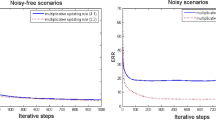Abstract
Matrix factorization in the context of dual numbers has found applications, in recent years, in fields such as kinematics and computer graphics. In this paper, we develop an efficient approach for handling large-scale data low-rank approximation problems using the UTV decomposition of dual matrices (DUTV). Theoretically, we propose an explicit expression for the DUTV and provide necessary and sufficient conditions for its existence. During this process, we also discovered that the general low-rank model for dual matrices can be solved by the Sylvester equation. In numerical experiments, the DUTV algorithm outperforms the dual matrix SVD algorithm in terms of speed and maintains effective performance in wave recognition. Subsequently, we utilize the DUTV algorithm to validate brain functional circuits in large-scale task-state functional magnetic resonance imaging data. Successfully identifying three types of wave signals, the DUTV method provides substantial empirical evidence for cognitive neuroscience theories.








Similar content being viewed by others
References
Angeles J (2012) The dual generalized inverses and their applications in kinematic synthesis. In: Latest advances in robot kinematics eds. Jadran Lenarcic and Manfred Husty Springer, Berlin, pp 1–10
Baksalary JK, Kala R (1979) The matrix equation \({AX - YB = C}\). Linear Algebra Appl 25:41–43
Baydin AG, Pearlmutter BA, Radul AA, Siskind JM (2018) Automatic differentiation in machine learning: a survey. J Mach Learn Res 18:1–43
Binder JR, Gross WL, Allendorfer JB, Bonilha L, Chapin J, Edwards JC, Grabowski TJ, Langfitt JT, Loring DW, Lowe MJ et al (2011) Mapping anterior temporal lobe language areas with fMRI: a multicenter normative study. Neuroimage 54(2):1465–1475
Candès EJ, Wakin MB (2008) An introduction to compressive sampling. IEEE Signal Process Mag 25(2):21–30
Clifford (1871) Preliminary sketch of biquaternions. Proc Lond Math Soc 1(1):381–395
Feeny B (2008) A complex orthogonal decomposition for wave motion analysis. J Sound Vib 310(1–2):77–90
Fliess M, Join C (2013) Model-free control. Int J Control 86(12):2228–2252
Fornberg B (1988) Generation of finite difference formulas on arbitrarily spaced grids. Math Comput 51(184):699–706
Friederici AD, Chomsky N, Berwick RC, Moro A, Bolhuis JJ (2017) Language, mind and brain. Nat Hum Behav 1(10):713–722
Golub GH, Van Loan CF (2013) Matrix computations, 4th edn. JHU Press, Baltimore
Gutin R (2022) Generalizations of singular value decomposition to dual-numbered matrices. Linear Multilinear Algebra 70(20):5107–5114
Halko N, Martinsson P-G, Tropp JA (2011) Finding structure with randomness: probabilistic algorithms for constructing approximate matrix decompositions. SIAM Rev 53(2):217–288
Kaloorazi MF, de Lamare RC (2019) Compressed randomized UTV decompositions for low-rank approximations in big data science. In: ICASSP 2019—2019 IEEE international conference on acoustics, speech and signal processing (ICASSP) IEEE Inc., New York, pp 7510–7514
Kutter EF, Boström J, Elger CE, Nieder A, Mormann F (2022) Neuronal codes for arithmetic rule processing in the human brain. Curr Biol 32(6):1275–1284
Pennestrì E, Stefanelli R (2007) Linear algebra and numerical algorithms using dual numbers. Multibody Syst Dyn 18:323–344
Pennestrì E, Valentini P, De Falco D (2018) The Moore-Penrose dual generalized inverse matrix with application to kinematic synthesis of spatial linkages. J Mech Des 140(10):102303
Peón R, Carvente O, Cruz-Villar CA, Zambrano-Arjona M, Peñuñuri F (2019) Dual numbers for algorithmic differentiation. Ingeniería 23(3):71–81
Qi L, Luo Z (2023) Eigenvalues and singular values of dual quaternion matrices. Pac J Optim 19(2):257–272
Qi L, Alexander DM, Chen Z, Ling C, Luo Z (2022) Low rank approximation of dual complex matrices. arXiv:2201.12781
Sakurai Y (2017) Brodmann areas 39 and 40: human parietal association area and higher cortical function. Brain Nerve 69(4):461–469
Sola J (2017) Quaternion kinematics for the error-state Kalman filter. arXiv:1711.02508
Stewart GW (1992) An updating algorithm for subspace tracking. IEEE Trans Signal Process 40(6):1535–1541
Stewart GW (1993) Updating a rank-revealing ULV decomposition. SIAM J Matrix Anal Appl 14(2):494–499
Study E (1903) Geometrie der Dynamen. Druck und verlag von BG Teubner
Udwadia FE (2021a) Dual generalized inverses and their use in solving systems of linear dual equations. Mech Mach Theory 156:104158
Udwadia FE (2021b) When does a dual matrix have a dual generalized inverse? Symmetry 13(8):1386
Udwadia FE, Pennestri E, de Falco D (2020) Do all dual matrices have dual Moore–Penrose generalized inverses? Mech Mach Theory 151:103878
Van Essen DC, Smith SM, Brch DM, Behrens TE, Yacoub E, Ugurbil K, Consortium W-MH et al (2013) The Wu-Minn human connectome project: an overview. Neuroimage 80:62–79
Wang H (2021) Characterizations and properties of the MPDGI and DMPGI. Mech Mach Theory 158:104212
Wang H, Cui C, Liu X (2023) Dual \( r \)-rank decomposition and its applications. Comput Appl Math. 42:349
Wei T, Ding W, Wei Y (2023) Singular value decomposition of dual matrices and its application to traveling wave identification in the brain. SIAM J Matrix Anal Appl (2023, to appear)
Xia M, Wang J, He Y (2013) BrainNet viewer: a network visualization tool for human brain connectomics. PLoS One 8(7):e68910
Acknowledgements
The authors would like to thank the managing editor and two referees for their very detailed comments, which have significantly improved the presentation of our manuscript.
Author information
Authors and Affiliations
Corresponding author
Ethics declarations
Conflict of interest
The authors have not disclosed any competing interests.
Additional information
Communicated by Wei Gong.
Publisher's Note
Springer Nature remains neutral with regard to jurisdictional claims in published maps and institutional affiliations.
R. Xu is supported by the National Natural Science Foundation of China under Grant 12271108 and Shanghai Municipal Science and Technology Commission under Grant 23WZ2501400. T. Wei is partially supported by the Science and Technology Commission of Shanghai Municipality (No. 23ZR1403000, 20JC1419500, 2018SHZDZX0). Y. Wei is supported by the National Natural Science Foundation of China under Grant 12271108, the Ministry of Science and Technology of China under Grant G2023132005L and Medical Engineering Joint Fund of Fudan University. H. Yan is supported by the Hong Kong Research Grants Council (Project 11204821), the Hong Kong Innovation and Technology Commission (InnoHK Project CIMDA) and City University of Hong Kong (Projects 9610034 and 9610460)
Rights and permissions
Springer Nature or its licensor (e.g. a society or other partner) holds exclusive rights to this article under a publishing agreement with the author(s) or other rightsholder(s); author self-archiving of the accepted manuscript version of this article is solely governed by the terms of such publishing agreement and applicable law.
About this article
Cite this article
Xu, R., Wei, T., Wei, Y. et al. UTV decomposition of dual matrices and its applications. Comp. Appl. Math. 43, 41 (2024). https://doi.org/10.1007/s40314-023-02565-7
Received:
Revised:
Accepted:
Published:
DOI: https://doi.org/10.1007/s40314-023-02565-7
Keywords
- Dual matrices
- UTV decomposition
- Low-rank approximation
- Randomized algorithm
- Traveling wave identification
- Brain dynamics




